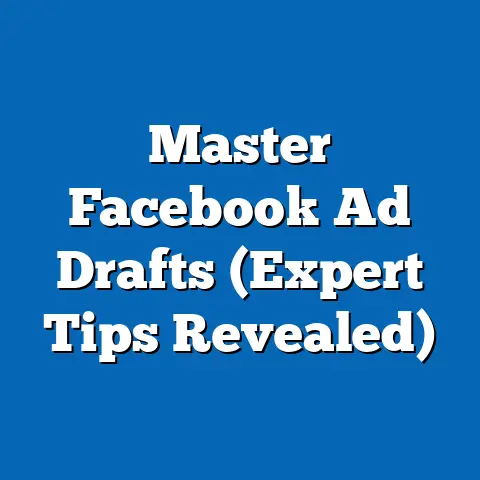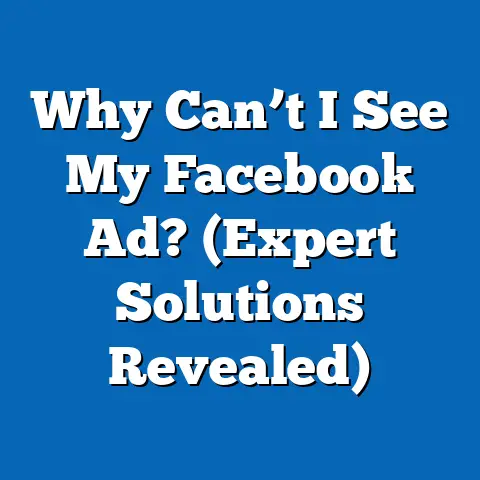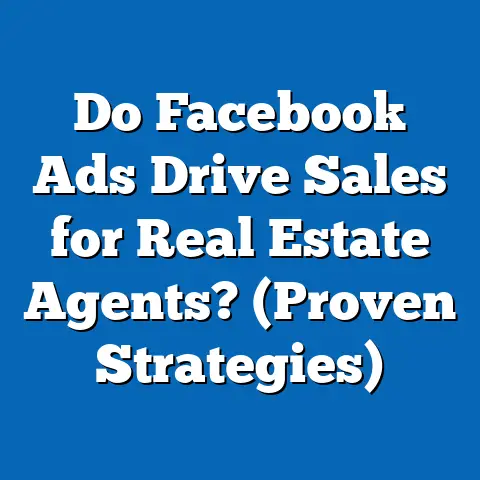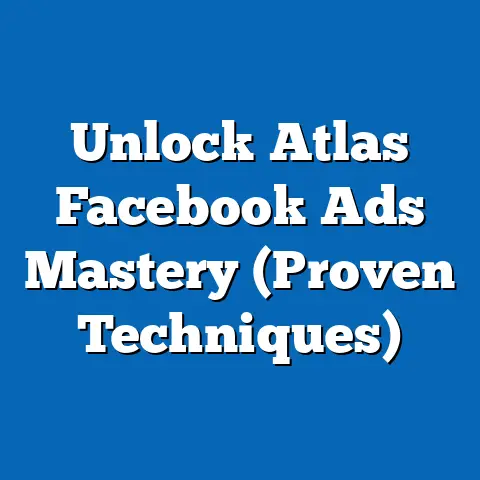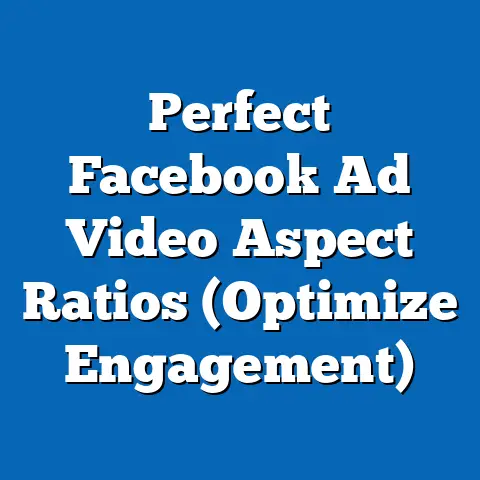Boost Sales with Facebook Ads Templates (Expert Strategies)
The digital marketing landscape is in constant flux. Businesses today are under immense pressure to adapt, evolve, and innovate to stay ahead of the competition. If you’re not constantly seeking new and effective strategies, you risk being left behind. And in this race, Facebook Ads remains one of the most powerful tools for reaching potential customers, driving traffic, and ultimately, boosting sales.
Consider this: millions of businesses are already utilizing Facebook Ads, and many are seeing a significant return on investment (ROI). I’ve personally witnessed firsthand the transformative power of a well-executed Facebook Ads campaign. But here’s the catch: the key to success lies in efficiency and optimization. Without immediate action and a strategic approach, you risk falling behind competitors who are already capitalizing on these tools.
That’s where Facebook Ads templates come in. They’re a game-changer! They offer a powerful solution to streamline ad creation, drastically reduce time spent on design, and empower marketers of all skill levels to create high-converting ads. Think of them as your secret weapon in the ever-evolving world of Facebook advertising.
Understanding Facebook Ads Templates
So, what exactly are Facebook Ads templates? Simply put, they are pre-designed layouts and formats within the Facebook Ads Manager that provide a framework for creating visually appealing and engaging ads. Think of them as blueprints that you can customize with your own copy, images, videos, and branding elements.
The Power of Templates: Saving Time and Maintaining Brand Consistency
The benefits of using templates are numerous. One of the most significant is the time-saving aspect. Instead of starting from scratch every time you want to create an ad, templates provide a ready-made structure that significantly reduces the design and setup process. I remember spending countless hours designing ads from the ground up, tweaking every element until it was “just right.” Templates would have saved me so much time and effort!
Another key benefit is brand consistency. Templates ensure that your ads maintain a consistent look and feel, reinforcing your brand identity across all your campaigns. This is crucial for building brand recognition and trust with your audience. With consistent branding, your audience will be able to identify your ads easily, regardless of the template used.
Furthermore, templates are incredibly user-friendly, making them accessible to marketers of all skill levels. Whether you’re a seasoned pro or just starting out, you can easily use templates to create professional-looking ads without needing extensive design skills.
Exploring Different Types of Facebook Ads Templates
Facebook offers a variety of templates to suit different marketing objectives. Some of the most popular types include:
- Carousel Ads: These templates allow you to showcase multiple images or videos within a single ad, each with its own headline, description, and link. They are perfect for highlighting different products, features, or benefits. I’ve used carousel ads to showcase different angles and features of a single product, leading to a significant increase in engagement and click-through rates.
- Slideshow Ads: These templates create a video-like experience by combining a series of images and videos. They are a cost-effective way to create engaging video content without the need for expensive video production. I’ve found slideshow ads to be particularly effective for showcasing customer testimonials or behind-the-scenes glimpses of a business.
- Collection Ads: These templates feature a main video or image above a collection of product images. When users click on the ad, they are taken to a full-screen experience where they can browse and purchase products. These are ideal for e-commerce businesses looking to drive sales directly from Facebook.
- Lead Generation Ads: These templates are designed to capture leads directly from Facebook without sending users to an external website. They include pre-filled forms that make it easy for users to provide their contact information. I’ve used these extensively for running contests and giveaways, generating a large number of qualified leads.
- Instant Experience Ads (formerly Canvas Ads): These templates create a full-screen, interactive experience within Facebook. They allow you to combine images, videos, text, and buttons to tell a compelling story about your brand or product. I’ve found these to be incredibly effective for showcasing complex products or services that require more explanation.
Takeaway: Facebook Ads templates are a powerful tool for streamlining ad creation, maintaining brand consistency, and achieving your marketing objectives. Experiment with different types of templates to find what works best for your business.
Crafting Compelling Copy for Your Ads
While visuals play a crucial role in capturing attention, the copy is what ultimately persuades users to take action. Compelling ad copy can make or break the effectiveness of your Facebook Ads, regardless of how visually appealing your template is.
The Art of the Headline: Grabbing Attention Instantly
Your headline is the first thing users see, so it needs to be attention-grabbing and relevant to their interests. A strong headline should:
- Be concise and clear: Get straight to the point and avoid jargon or overly complicated language.
- Highlight a benefit: Focus on what the user will gain by clicking on your ad.
- Create a sense of urgency: Use words like “now,” “today,” or “limited time” to encourage immediate action.
- Use numbers and statistics: Numbers can make your headline more credible and attention-grabbing.
For example, instead of a generic headline like “Learn More About Our Product,” try something like “Get 20% Off Our Best-Selling Product Today Only!” or “Discover the 5 Secrets to [Achieving Desired Outcome].”
I’ve seen headlines that incorporate questions to be highly effective. For instance, “Struggling with [Problem]? We Have the Solution!” can pique curiosity and encourage clicks.
Clear and Concise Messaging: Communicating Your Value Proposition
Once you’ve captured attention with your headline, the body of your ad copy needs to clearly communicate your value proposition. Explain what your product or service is, what problem it solves, and why users should choose you over the competition. Keep your messaging concise and avoid overwhelming users with too much information.
- Focus on benefits, not features: Instead of listing the features of your product, focus on the benefits users will experience. For example, instead of saying “Our product has a 1000mAh battery,” say “Enjoy all-day battery life with our long-lasting product.”
- Use simple language: Avoid technical jargon and write in a way that is easy for anyone to understand.
- Highlight social proof: Include testimonials, reviews, or case studies to build trust and credibility.
- Address potential objections: Anticipate any concerns users might have and address them directly in your ad copy.
Strong Calls-to-Action (CTAs): Guiding Users to Convert
Your call-to-action (CTA) is the final nudge that encourages users to take the desired action, whether it’s visiting your website, making a purchase, or signing up for a newsletter. Your CTA should be clear, concise, and action-oriented.
- Use strong action verbs: Start your CTA with words like “Shop,” “Learn,” “Sign Up,” “Download,” or “Get Started.”
- Create a sense of urgency: Add phrases like “Now,” “Today,” or “Limited Time Offer” to encourage immediate action.
- Make it visually prominent: Use a button or a different font color to make your CTA stand out.
- Test different CTAs: Experiment with different wording to see which one performs best.
Some effective CTA examples include:
- “Shop Now and Get Free Shipping”
- “Learn More About Our Exclusive Offer”
- “Sign Up Today and Get a Free Ebook”
- “Download Your Free Trial Now”
I’ve found that personalizing the CTA can also be effective. For example, “Claim My Discount” or “Start My Free Trial” can create a sense of ownership and encourage clicks.
Real-World Examples of Successful Ad Copy
Let’s look at some examples of successful ad copy that has led to increased engagement and sales:
-
Example 1: Shopify
- Headline: Start Your Online Store Today – Free Trial
- Body: Shopify makes it easy to create a beautiful online store and sell your products to customers around the world. Start your free trial today and see how Shopify can help you grow your business.
- CTA: Start Free Trial
- Why it works: The headline is clear and concise, highlighting the benefit of starting an online store. The body provides a brief overview of Shopify’s value proposition, and the CTA is direct and action-oriented.
-
Example 2: Grammarly
-
Headline: Improve Your Writing Instantly – Grammarly
- Body: Grammarly helps you write clearly and confidently by providing real-time feedback on your grammar, spelling, and style. Try Grammarly today and see the difference it can make in your writing.
- CTA: Get Grammarly
- Why it works: The headline focuses on the immediate benefit of using Grammarly. The body highlights the key features and benefits, and the CTA is simple and memorable.
Example 1: Shopify
- Headline: Start Your Online Store Today – Free Trial
- Body: Shopify makes it easy to create a beautiful online store and sell your products to customers around the world. Start your free trial today and see how Shopify can help you grow your business.
- CTA: Start Free Trial
- Why it works: The headline is clear and concise, highlighting the benefit of starting an online store. The body provides a brief overview of Shopify’s value proposition, and the CTA is direct and action-oriented.
-
Example 2: Grammarly
-
Headline: Improve Your Writing Instantly – Grammarly
- Body: Grammarly helps you write clearly and confidently by providing real-time feedback on your grammar, spelling, and style. Try Grammarly today and see the difference it can make in your writing.
- CTA: Get Grammarly
- Why it works: The headline focuses on the immediate benefit of using Grammarly. The body highlights the key features and benefits, and the CTA is simple and memorable.
Example 2: Grammarly
Headline: Improve Your Writing Instantly – Grammarly
Takeaway: Compelling ad copy is essential for driving conversions on Facebook. By crafting attention-grabbing headlines, clear and concise messaging, and strong calls-to-action, you can significantly improve the performance of your ads.
Design and Visual Elements
Now that we’ve covered the importance of compelling copy, let’s move on to the visual elements of your Facebook Ads. While words are important, visuals are what initially grab the user’s attention and make them want to learn more.
The Power of Visuals: Capturing Attention and Conveying Your Message
Visuals play a crucial role in the effectiveness of your Facebook Ads. A well-designed image or video can:
- Capture attention: In a crowded news feed, eye-catching visuals can help your ad stand out from the competition.
- Convey your message: Visuals can communicate your value proposition quickly and effectively.
- Evoke emotions: Visuals can create an emotional connection with your audience, making your ad more memorable.
- Drive engagement: Engaging visuals can encourage users to click on your ad, visit your website, or make a purchase.
Best Practices for Selecting Images, Colors, and Fonts
When selecting visuals for your Facebook Ads, it’s important to consider the following best practices:
- Choose high-quality images: Use images that are clear, crisp, and well-lit. Avoid blurry or pixelated images.
- Align with your brand identity: Use images, colors, and fonts that are consistent with your brand identity. This will help reinforce brand recognition and build trust with your audience.
- Use relevant images: Choose images that are relevant to your product or service and that resonate with your target audience.
- Use contrasting colors: Use colors that contrast with the background of your ad to make your visuals stand out.
- Choose readable fonts: Use fonts that are easy to read, even at small sizes. Avoid overly decorative or script fonts.
- Test different visuals: Experiment with different images, colors, and fonts to see what performs best with your target audience.
I’ve found that using images that feature people, especially those showing genuine emotion, can be incredibly effective. People connect with people, and these types of images can create a more personal and relatable experience.
The Impact of Video Content: Engaging Your Audience on a Deeper Level
Video content is becoming increasingly popular on Facebook, and for good reason. Videos are highly engaging and can convey a lot of information in a short amount of time.
- Grab attention quickly: Start your video with a compelling hook that grabs the viewer’s attention within the first few seconds.
- Keep it short and sweet: Aim for videos that are 15-30 seconds long.
- Tell a story: Use your video to tell a story about your brand or product.
- Use captions: Many users watch videos with the sound off, so it’s important to include captions.
- Include a call-to-action: End your video with a clear call-to-action that tells viewers what you want them to do next.
Facebook Ads templates can make it easy to integrate video content into your ads. Many templates include pre-designed video layouts that you can customize with your own footage and branding elements.
I’ve personally seen a significant increase in engagement and conversions when using video ads. They allow you to connect with your audience on a deeper level and showcase your product or service in a dynamic and engaging way.
Examples of Visually Appealing Ads Using Templates
Let’s look at some examples of visually appealing ads that have successfully utilized templates:
-
Example 1: Nike
- Nike often uses visually stunning images and videos in their Facebook Ads to showcase their latest products and inspire their audience. They use templates to create a consistent brand experience across all their ads.
- Key takeaway: Use high-quality visuals and maintain a consistent brand identity.
-
Example 2: Airbnb
-
Airbnb uses beautiful images of homes and destinations in their Facebook Ads to entice users to book their next vacation. They use templates to create visually appealing ads that are easy to browse and navigate.
- Key takeaway: Use relevant and appealing visuals that showcase the benefits of your product or service.
-
Example 3: Dove
-
Dove uses authentic and relatable videos in their Facebook Ads to promote their brand values and connect with their audience. They use templates to create visually engaging ads that tell a story and evoke emotions.
- Key takeaway: Use video content to connect with your audience on a deeper level and convey your brand values.
Example 1: Nike
- Nike often uses visually stunning images and videos in their Facebook Ads to showcase their latest products and inspire their audience. They use templates to create a consistent brand experience across all their ads.
- Key takeaway: Use high-quality visuals and maintain a consistent brand identity.
-
Example 2: Airbnb
-
Airbnb uses beautiful images of homes and destinations in their Facebook Ads to entice users to book their next vacation. They use templates to create visually appealing ads that are easy to browse and navigate.
- Key takeaway: Use relevant and appealing visuals that showcase the benefits of your product or service.
-
Example 3: Dove
-
Dove uses authentic and relatable videos in their Facebook Ads to promote their brand values and connect with their audience. They use templates to create visually engaging ads that tell a story and evoke emotions.
- Key takeaway: Use video content to connect with your audience on a deeper level and convey your brand values.
Example 2: Airbnb
Airbnb uses beautiful images of homes and destinations in their Facebook Ads to entice users to book their next vacation. They use templates to create visually appealing ads that are easy to browse and navigate.
Example 3: Dove
Dove uses authentic and relatable videos in their Facebook Ads to promote their brand values and connect with their audience. They use templates to create visually engaging ads that tell a story and evoke emotions.
Takeaway: Design and visual elements are crucial for capturing attention and conveying your message in Facebook Ads. By selecting high-quality images, aligning with your brand identity, and incorporating video content, you can create visually appealing ads that drive engagement and conversions.
Targeting Your Audience Effectively
You can have the most compelling copy and visually stunning ads, but if you’re not showing them to the right people, you’re wasting your time and money. Effective audience targeting is essential for the success of your Facebook Ads campaigns.
The Importance of Audience Targeting: Reaching the Right People
Audience targeting allows you to show your ads to specific groups of people based on their demographics, interests, behaviors, and other characteristics. This ensures that your ads are seen by people who are most likely to be interested in your product or service.
- Increase relevance: By targeting your ads to the right people, you can increase the relevance of your ads and improve your click-through rates (CTR).
- Improve conversion rates: When you show your ads to people who are genuinely interested in your product or service, you’re more likely to see higher conversion rates.
- Reduce ad spend: By targeting your ads effectively, you can reduce your ad spend by showing your ads only to people who are likely to convert.
- Maximize ROI: Effective audience targeting allows you to maximize your return on investment (ROI) by getting the most out of your ad budget.
Exploring Facebook’s Targeting Options: Demographics, Interests, Behaviors, and Custom Audiences
Facebook offers a wide range of targeting options to help you reach your ideal audience. Some of the most popular options include:
- Demographics: Target users based on their age, gender, location, education, relationship status, and other demographic characteristics.
- Interests: Target users based on their interests, hobbies, and the pages they like on Facebook.
- Behaviors: Target users based on their online behavior, such as their purchase history, the devices they use, and the ads they click on.
- Custom Audiences: Create custom audiences based on your existing customer data, such as email lists, website visitors, or app users.
- Website Custom Audiences (Retargeting): Showing ads to people who have visited your website is a powerful way to re-engage potential customers.
- Lookalike Audiences: Facebook can create a lookalike audience based on your existing custom audience, targeting users who share similar characteristics and interests.
- Website Custom Audiences (Retargeting): Showing ads to people who have visited your website is a powerful way to re-engage potential customers.
- Lookalike Audiences: Facebook can create a lookalike audience based on your existing custom audience, targeting users who share similar characteristics and interests.
I’ve found that combining different targeting options can be incredibly effective. For example, you could target women aged 25-34 who are interested in fashion and have recently visited your online store.
Expert Strategies for Segmenting Audiences and Tailoring Ads
To maximize the effectiveness of your audience targeting, it’s important to segment your audiences and tailor your ads to specific groups.
- Create buyer personas: Develop detailed profiles of your ideal customers, including their demographics, interests, behaviors, and pain points.
- Segment your audience: Divide your audience into smaller groups based on their characteristics and interests.
- Tailor your ad copy and visuals: Create ad copy and visuals that resonate with each specific audience segment.
- Use dynamic ads: Dynamic ads automatically show users products they have previously viewed on your website, increasing the likelihood of a purchase.
- Test different targeting options: Experiment with different targeting options to see what performs best for your business.
Case Studies of Successful Audience Targeting with Templates
Let’s look at some examples of businesses that have successfully targeted their audiences using Facebook Ads templates:
-
Example 1: A Local Restaurant
- A local restaurant uses Facebook Ads to target people who live within a 5-mile radius of their location and are interested in food and dining. They use a carousel ad template to showcase their menu items and special offers.
- Key takeaway: Target local audiences with relevant offers and visually appealing ads.
-
Example 2: An Online Clothing Retailer
-
An online clothing retailer uses Facebook Ads to target women aged 18-34 who are interested in fashion and have previously visited their website. They use a dynamic ad template to show users products they have viewed but not purchased.
- Key takeaway: Use retargeting to re-engage website visitors and show them products they are already interested in.
-
Example 3: A Software Company
-
A software company uses Facebook Ads to target business owners and entrepreneurs who are interested in productivity and time management. They use a lead generation ad template to collect leads and offer a free trial of their software.
- Key takeaway: Target specific audiences based on their interests and offer a valuable incentive to encourage them to take action.
Example 1: A Local Restaurant
- A local restaurant uses Facebook Ads to target people who live within a 5-mile radius of their location and are interested in food and dining. They use a carousel ad template to showcase their menu items and special offers.
- Key takeaway: Target local audiences with relevant offers and visually appealing ads.
-
Example 2: An Online Clothing Retailer
-
An online clothing retailer uses Facebook Ads to target women aged 18-34 who are interested in fashion and have previously visited their website. They use a dynamic ad template to show users products they have viewed but not purchased.
- Key takeaway: Use retargeting to re-engage website visitors and show them products they are already interested in.
-
Example 3: A Software Company
-
A software company uses Facebook Ads to target business owners and entrepreneurs who are interested in productivity and time management. They use a lead generation ad template to collect leads and offer a free trial of their software.
- Key takeaway: Target specific audiences based on their interests and offer a valuable incentive to encourage them to take action.
Example 2: An Online Clothing Retailer
An online clothing retailer uses Facebook Ads to target women aged 18-34 who are interested in fashion and have previously visited their website. They use a dynamic ad template to show users products they have viewed but not purchased.
Example 3: A Software Company
A software company uses Facebook Ads to target business owners and entrepreneurs who are interested in productivity and time management. They use a lead generation ad template to collect leads and offer a free trial of their software.
Takeaway: Effective audience targeting is crucial for the success of your Facebook Ads campaigns. By understanding your target audience, segmenting them effectively, and tailoring your ads to their specific needs and interests, you can significantly improve your results.
Analyzing and Optimizing Your Ad Performance
Creating a great ad and targeting the right audience is only half the battle. The other half is analyzing your ad performance and making adjustments to optimize for maximum ROI.
The Importance of Data Analytics: Measuring Your Success
Data analytics allows you to track the performance of your Facebook Ads and identify areas for improvement. By monitoring key performance indicators (KPIs), you can gain valuable insights into what’s working and what’s not.
- Identify trends: Data analytics can help you identify trends in your ad performance, such as which ads are performing best, which audiences are most responsive, and which times of day are most effective.
- Make data-driven decisions: By analyzing your data, you can make informed decisions about how to optimize your ads and improve your results.
- Reduce ad spend: Data analytics can help you identify underperforming ads and audiences, allowing you to reduce your ad spend and focus on what’s working.
- Maximize ROI: By continuously analyzing and optimizing your ad performance, you can maximize your return on investment (ROI).
Key Performance Indicators (KPIs) to Monitor
Here are some of the most important KPIs to monitor when analyzing your Facebook Ads performance:
- Click-Through Rate (CTR): The percentage of people who see your ad and click on it. A high CTR indicates that your ad is relevant and engaging to your target audience.
- Cost Per Click (CPC): The average cost you pay for each click on your ad. A low CPC indicates that you are targeting your audience effectively and that your ad is resonating with them.
- Conversion Rate: The percentage of people who click on your ad and complete a desired action, such as making a purchase, signing up for a newsletter, or downloading a free resource. A high conversion rate indicates that your ad is effective at driving conversions.
- Cost Per Conversion (CPC): The average cost you pay for each conversion. A low CPC indicates that you are optimizing your ads effectively and that you are getting a good return on your investment.
- Return on Ad Spend (ROAS): The amount of revenue you generate for every dollar you spend on advertising. A high ROAS indicates that your ads are highly profitable.
A/B Testing: Finding What Works Best
A/B testing, also known as split testing, involves creating two or more versions of your ad and showing them to different segments of your audience to see which one performs best.
- Test different headlines: Experiment with different headlines to see which one grabs the most attention.
- Test different ad copy: Experiment with different ad copy to see which one resonates most with your audience.
- Test different visuals: Experiment with different images and videos to see which one drives the most engagement.
- Test different targeting options: Experiment with different targeting options to see which one reaches the most responsive audience.
- Test different CTAs: Experiment with different calls-to-action to see which one drives the most conversions.
I’ve found that even small changes can have a significant impact on ad performance. For example, simply changing the wording of your CTA can increase your conversion rate by several percentage points.
Using Insights to Refine Your Ad Strategies
Once you’ve gathered enough data from your A/B tests, you can use those insights to refine your ad strategies and improve your future campaigns.
- Focus on what’s working: Identify the ads, audiences, and strategies that are performing best and focus your efforts on those areas.
- Eliminate what’s not working: Identify the ads, audiences, and strategies that are underperforming and eliminate them from your campaigns.
- Continuously test and optimize: Continue to test and optimize your ads to stay ahead of the curve and ensure that you are always getting the best possible results.
Takeaway: Data analytics and A/B testing are essential for optimizing your Facebook Ads performance. By monitoring key performance indicators, testing different ad variations, and using insights to refine your ad strategies, you can significantly improve your results and maximize your ROI.
Conclusion
In the fast-paced world of digital marketing, the ability to adapt quickly and efficiently is paramount. Facebook Ads remains a powerful tool for reaching potential customers and driving sales, but only if utilized effectively. I’ve shared my experiences and insights, highlighting the potential for increased sales and customer engagement when businesses leverage these expert strategies.
Facebook Ads templates offer a streamlined approach to ad creation, saving time and ensuring brand consistency. By crafting compelling copy, designing visually appealing ads, targeting your audience effectively, and analyzing your ad performance, you can create campaigns that drive real results.
I encourage you to take immediate action by utilizing the insights and tips provided in this article to create your own compelling Facebook Ads that drive real results. Remember, in the competitive landscape of digital marketing, every moment counts, and those who act now will be the ones who thrive. The time to boost your sales with Facebook Ads templates is now.

